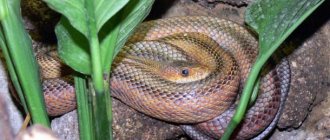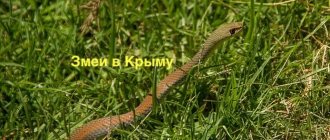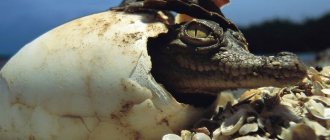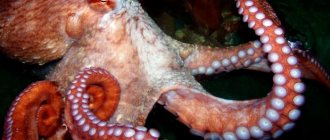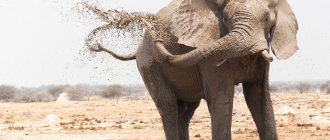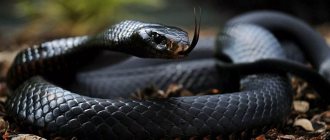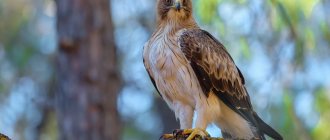After the death of dinosaurs at the end of the Mesozoic era, which became extinct either due to the fall of a giant meteorite into the Gulf of Mexico, or due to increased volcanic activity on Earth, the surviving large reptiles had no competitors left, and they began to evolve intensively, increasing in size. A striking representative of the crawling reptiles that lived on the planet at the beginning of the Cenozoic 6058 million years ago was the giant snake (swamp boa) titanoboa (Titanoboa cerrejonensis). Paleontologists discovered the skeletal remains in Colombia, in coal mines called Pit La Puente, in 2009. Today, titanoba, an extinct species of snake, is considered the largest scaly, pseudolegged reptile that has ever lived on our planet.
Poisonous giants
King Cobra
The longest snake dangerous to humans. The reptile grows up to 5 meters in length.
Lives in India, Southern China, and the Philippines. Lives in the forest, but is also found near human habitation. Feels good in the canopy of trees and is a fast and skilled swimmer. The cobra has a slender, yellowish-green body with black rings.
In addition to size, the cobra differs from other reptiles:
- Long life expectancy;
- Snake venom is toxic, 6-8 milligrams kills a person in a quarter of an hour. It happens that even elephants die from its bite.
- The cobra grows throughout its life, so large specimens are found in nature;
- This reptile can eat small snakes, including poisonous ones.
In some situations, the cobra behaves aggressively, attacks and chases people. This happens because a person is near a reptile's nest. The reptile diligently protects the masonry from danger.
He fasts without harm for two to three months. If the snake is disturbed and it senses danger, the reptile will try to scare off the enemy before attacking by rising above the ground and stretching its hood.
Gyurza
The largest snake in Central Asia. Reaches 2 meters in length and three kilograms in weight.
Its body is sandy or brown in color, and there are a number of brown spots on its back. Hunts lizards, rodents, small turtles and birds.
The venom of the viper is toxic to humans; its bite causes internal hemorrhages and thrombosis. In the absence of medical attention, a snake attack can be fatal.
Black Mamba
The reptile is dark brown on top and dirty white underneath. It grows up to four meters in length, is poisonous and dangerous. During an attack, it can reach speeds of up to 19 km/h. Often attacks suddenly and without reason. Mamba venom is dangerous to humans. If an antidote is not administered, the person bitten by the snake quickly dies.
The snake is found in Africa, in savannas and low forests. Mamba does not live in rain forests or thickets. Hunts small rodents, birds, lizards and other snakes. It attacks most often during the day. A well-aimed throw from an ambush, a few bites and the rodent dies 3-5 seconds after the attack. Mamba digestion of prey continues for more than a day.
Bushmaster
This poisonous snake lives in Central and South America. The length of her body reaches 3.5 meters. The color of the reptile is light brown, with dark diamonds. The bushmaster lives in dense forests, closer to bodies of water.
The reptile hunts at dusk, its prey being birds and small mammals. The snake has long poisonous teeth - 2.5 centimeters. When bitten, more than 5 milliliters of poison enters the victim’s body.
The reptile rarely attacks humans. Snakes avoid settlements and hide from people in dense thickets.
Common boa constrictor
Currently, 10 subspecies are known, which differ from each other in both habitat and body color. As a rule, due to their special color, boas are easily camouflaged in the natural environment
This is especially important for them since they lead an isolated lifestyle.
In the natural environment, ordinary boas grow up to 5 and a half meters in length, gaining weight up to 25 kilograms. If kept in captivity, they do not grow more than 3 meters. The common boa constrictor is found throughout Central and South America, as well as in the Lesser Antilles. For their life activities, these reptiles choose dry areas, but not far from various bodies of water.
The diet of the boa constrictor is no different, since it consists of birds, small mammals, and reptiles. The boa constrictor kills its victim in a special way, squeezing the chest. In other words, it simply suffocates living beings.
3. Burmese python or dark tiger Length 5.8 m
Among pythons with a color like a tiger, this species will be the largest. It lives in Asian countries such as China, Thailand, Indonesia, Vietnam, and also in India. The record length of the Burmese python was 8-9 m with a weight of 70 kg, but specimens with a length of up to 5.8 m are most often found. Such dimensions allow us to place the tiger python in third place in the ranking of the longest snakes in the world. Pythons love swampy areas and tropical rainforests. They are excellent swimmers, and light-weight young individuals can nimbly climb trees. A calm python, sitting in a secluded place, can determine the location of prey using thermolocators, capturing thermal radiation and smell. It eats birds, rodents, monkeys, but can attack a pig or goat. These snakes are often kept as pets, although this is an expensive hobby.
What did Titanoboa eat?
Photo: Ancient Titanoboa
Based on the structure of its teeth, scientists believe that the snake ate mainly fish. No fossilized remains were found inside the skeletons of giant snakes, however, due to the sedentary lifestyle and its physiology, it follows that the snake did not consume large prey.
Not all scientists agree that Titanoboa was exclusively piscivorous. Many believe that the snake’s huge body also required a large amount of energy, which it simply could not get from fish. Therefore, there are suggestions that the following creatures of the Paleocene era could become victims of Titanoboa.
Cubs of Carodnia - large mammals that lived in the same area as Titanoboa;
- Mongoloteria;
- Plesiadapis;
- Phenacodus in the Late Paleocene.
There are also suggestions that the snake did not hunt in the usual way for pythons. Initially, it was believed that Titanoboa wrapped rings around its prey and squeezed it, breaking bones and interrupting breathing. In fact, Titanoboa used camouflage by diving into muddy water and hiding at the bottom.
When the prey approached the water's edge, the snake made a swift lunge, grabbed the prey with powerful jaws, instantly breaking its bones. This method of hunting is not typical for non-venomous snakes, but is used by crocodiles.
Origin of the species and description
Photo: Titanoboa
Titanoboa is a species of extinct snake classified in the only genus Titanoboa. Based on the structure of the skeleton, scientists conclude that the snake was a close relative of the boa constrictor. Its name also indicates this, since Boa is Latin for “boa constrictor.”
The first complete remains of Titanoboa were found in Colombia. Researchers have found that the snake lived about 60 million years ago. This snake appeared after the death of the dinosaurs - then life on Earth was restored and gained strength for several million years.
Video: Titanoboa
These remains were a real find for scientists - there were as many as 28 individuals. Previously, only vertebrae had been found in South America, so this creature remained a mystery to researchers. It was only in 2008 that Jason Head, at the head of his team, described such a species as Titanoboa.
Titanoboa lived during the Paleocene era, a period when many of the planet's living creatures were gigantic due to gravitational and atmospheric changes. Titanoboa confidently occupied a niche in the food chain, becoming one of the most formidable predators of its era.
Not so long ago, Gigantophys was considered the largest snake to ever exist, reaching a length of 10 meters. Titanoboa surpassed it in length and surpassed it in weight. It is also considered a more dangerous snake than its predecessor, since it hunted very large prey.
9. Deschauensei's anaconda (Eunectes deschauenseei) up to 30 kg
Deschauensei's Anaconda or "dark anaconda" is a giant reptile that lives most of its life under or on the surface of water. An adult has a body up to two meters long and weighs up to 30 kilograms. Such proportions of its body not only surprise people, but also make this snake an ideal hunter with high muscle strength, reaction and speed. The voracity of the dark anaconda is surprising: it can eat everything it comes across, from fish and turtles to chickens and piglets. The peculiarity of this species of snake is that it was found exclusively in Bolivia, in swampy and sparsely populated regions, which is why practically nothing is known about the Deschauensei anaconda.
How long is the giant snake?
Fossils found during archaeological excavations make it possible to completely reconstruct the appearance and outstanding dimensions of the ancient monster. Scientists have found that the Titanoboa snake reached a length of 15 meters. At the same time, the thickness of the reptile’s body exceeded the waist circumference of the average person. At its thickest point, the snake's body girth could reach 100 centimeters.
The direct descendants of Titanoboa are modern boa constrictors. Presumably, the ancient monster also wrapped itself around and squeezed its prey in a fatal embrace. But during the meal, the extinct snake Titanoboa looked more like a modern anaconda. This reptile could swallow almost any animal and was at the top of the food chain. According to experts, the weight of a well-fed Titanoboa could exceed 1 ton.
Best articles: Beautiful nicknames for boys hamsters. What name should you choose for your hamster?
Interesting facts about the record-breaking snake
Like its descendants, the Titanoboa snake was not poisonous. Thanks to its size and developed muscles, this reptile could easily cope with adult alligators.
The discovery of the fossilized remains of a giant snake gave rise to thinking about the climatic conditions in the animal’s habitat. Most scientists agree that the reptile thrived in the hot and humid tropical climate. Some experts, on the contrary, believe that the average annual temperature in the study area has risen by several degrees over the past millions of years. According to their calculations, the giant snake produced too much metabolic heat while digesting food. At excessively elevated temperatures, the reptile would simply overheat.
Scientists agree on only one thing: titanoboa is an extinct species of snake that can hunt in water and on land. Despite its fantastic size, the reptile moved as quickly as its modern descendants. This means that the animal chosen by the snake as prey simply had no chance.
Where did Titanoboa live?
Photo: Titanoboa snake
All snakes are cold-blooded, and Titanoboa was no exception. Therefore, the habitat of this snake should be warm or hot, with a tropical or subtropical climate. The average annual temperature for such a snake should be at least 33 degrees Celsius. The warm climate allowed these snakes to reach enormous sizes.
The remains of these snakes were found at the following locations:
- Southeast Asia;
- Colombia;
- Australia.
The first remains were found at the bottom of a Colombian mine in Carregion. However, it is worth making an error for the change in the position of the continents and climate change, which makes it difficult to establish the exact habitat of Titanoboa.
Specialist Mark Denny claims that Titanoboa was so enormous in size that it produced a colossal amount of heat from metabolic processes. Because of this, the temperature of the environment around this creature must have been four or six degrees lower than what many other scientists claim. Otherwise, Titanoboa would overheat.
It was reliably established that Titanoboa definitely lived in tropical and subtropical rain forests. She preferred to hide in muddy rivers and lakes, from where she conducted her hunt. Snakes of this size moved extremely slowly, rarely crawled out of their shelters and, moreover, did not crawl through trees, as many boas and pythons do. To support this, scientists draw analogies with the modern anaconda, which leads just such a lifestyle.
Haast's eagle
Of course, it’s good to know that most of the creatures we talked about today have never lived next to people. They disappeared long before man appeared. However, 500-600 years ago, a similar creature that could eat a person lived in New Zealand.
According to Birds Online, the Haast's eagle had a wingspan of more than three meters, and the power of its legs and talons could easily rival a modern tiger. Indigenous New Zealanders tell a legend about how Haast eagles abducted children, so you shouldn’t even imagine what the revival of this bird would threaten humanity with.
Found a violation? Report content
Anaconda
This snake is a member of the boa constrictor subfamily and has several names. It is called the common anaconda, giant anaconda or green anaconda, although it is generally called, as in the past, the water boa, since the snake prefers to live in water. The main habitat of the anaconda extends to the basins of the Orinaco and Amazon rivers, while the snake chooses areas where the current is weak or non-existent.
The size of the anaconda is no less impressive. Evidence of this is the fact that a snake more than 5 meters long (without a tail) that weighed 97 and a half kilograms was caught in Venezuela. It was a female specimen. As for males, they are not so impressive in size, and they are also weaker than females.
An amazing fact is that fish is not the main dish for the anaconda, despite the fact that it lives in water and rarely appears on land. As a rule, this boa constrictor prefers to hunt waterfowl, caimans, capybaras, iguanas, agoutis and other mammals and reptiles no larger than medium size. This snake's diet includes lizards, turtles, and other types of snakes. It is known that the water boa hunts pythons if their length is no more than 2 and a half meters.
7 BIGGEST SNAKES CAUGHT ON CAMERA
Social structure and reproduction
Photo: Giant Titanoboa
It is extremely difficult to establish the period in which titanoboa mating games began. It is only possible to guess how the seasonal reproduction of these snakes took place, based on already known facts about the reproduction of anacondas and boa constrictors. Titanoboa were oviparous snakes. The breeding season occurred when the air temperature began to rise after a seasonal decline - roughly speaking, during the spring-summer period, when the rainy season began.
Since Titanoboa lived solitarily, males had to search for females on their own. Most likely, in a certain territorial area there was one male and several females with whom he could mate.
It is difficult to guess whether titanoboa males had fights among themselves for the right to mate. Modern non-venomous snakes are not characterized by conflict, and females independently choose the male they like best, if there is a choice, without any show fights. As a rule, the largest male gets the right to mate - the same can be applied to Titanoboa.
Females laid eggs near their natural habitat - lakes, rivers or swamps. Anacondas and boa constrictors jealously guard the laid eggs, so it can be assumed that titanoboa females regularly visited the clutch and protected it from attacks by predators. During this time, large snakes stop eating and become exhausted, since the males do not take any part in nursing the eggs.
At first, newborn snakes were close to their mother, although they were large enough to hunt on their own. Later, the surviving individuals found a secluded territory where they continued to exist.
Anaconda (Eunectes murinus)
The most common scientific name for this large snake is “Green Anaconda” or “Giant Anaconda”. In the old days, people called this giant “Water Boa” and they were right in some ways, because the anaconda belongs to the subfamily of boas.
Europeans learned about this large snake from the notes of the Portuguese traveler “Chronicles of Peru” in 1553.
Today, Anaconda is the most massive snake living on earth. The length of an adult reaches 7 meters. There is evidence from the category “fear has big eyes” about 11 and even 12-meter specimens
But all this is from the category of human fantasies, which Thebiggest.ru does not take into account
The color of the snake is grayish-green with two rows of dark spots. Anaconda inhabited the entire tropical part of South America. She mainly chooses hard-to-reach places, so human encounters with her occur very rarely.
The snake spends most of its life in water. This large predator also hunts in water. It feeds on rodents and reptiles that live in bodies of water. It crawls onto the shore to bask in the sun.
There are very few recorded cases of snake attacks on humans in history. But still, a snake that weighs almost 100 kg can pose a danger to humans. But it poses a greater threat to domestic animals: pigs, goats.
Due to its size, the anaconda is widely represented in legends. The ancient inhabitants of the banks of the Amazon worshiped her as a Deity.
1
Titanoboa in art and popular culture
Legends about giant snakes are present in the cultural traditions of many countries around the world. Who knows, maybe our ancestors actually sometimes met with descendants of Titanoboa, larger in size than modern boa constrictors?
The skeleton of a giant ancient snake is now on display in the New York Museum, and anyone can see it with their own eyes. At the National Museum of Natural History (Washington) you can see a stunning sculpture. There, in the middle of the exhibition hall, a Titanoboa snake, made in its real scale, swallows an alligator.
The National Geographic Society has created a detailed documentary about the giant reptile. Titanoboa also appears in modern art in the form of an ancient, creepy monster. For example, this snake can be seen in the second episode of the series “Jurassic Portal: The New World.”
Are beautiful snakes dangerous?
Each snake is dangerous in its own way:
King cobra venom can kill a person in 15 minutes. However, she does not waste it in vain and in relation to a person she often produces “idle bites,” that is, without poison. And in the end it turns out that only 10% of attacks become fatal;
the eastern green mamba, although it can kill a person, prefers to run away from him;
the teeth of even the largest representatives of royal striated snakes are usually small and are not capable of causing significant harm to humans. Often these individuals become completely tame over time, although this will require long-term taming of the reptile; As for Dominican boas, they are very friendly towards humans. This is partly due to their laziness. During the day they are usually passive or even sleep;
garter snakes are not aggressive and are relatively easy to care for;
tiger pythons are most often kept in terrariums and, despite their size, do not pose a threat to humans, since they usually feed on rodents or birds and do not like to switch to other food;
The grassy-green whipweed from the Colubridae family is considered a poisonous snake, but not dangerous to humans. The fact is that its poisonous teeth are located very deep in its mouth and can pierce the skin only if the snake moves its jaws for a long time. Only in this case is it possible to get seriously poisoned;
Among serpentologists, rainbow boas are famous for their peaceful nature. It is difficult to anger them, but in case of danger, he can begin to hiss and even bite
Although a snake is capable of dragging a person under water, in life it tries to avoid close contacts with people;
the Texas snake is not poisonous, but is very aggressive if it senses danger, which should be taken into account by beginners who want to get such a pet; but tree vipers are aggressive and can rush at the intended enemy, inflicting poisonous bites. They are very sensitive to any irritants
Although due to the small amount of toxins there have been only two recorded cases of death from a rough tree viper bite, approaching them is strictly not recommended.
Did you know? When in danger, Cuban rainbow boas often curl up into a ball, their eyes turn red, and drops of blood appear in their mouths.
A bird that can be compared in size to an airplane
The wingspan of the F-104 Starfighter is just under seven meters. That is, the same as that of Argentavis magnificens. But only in the first case we are talking about an airplane, and in the second - about a bird the size of an airplane.
“Fisherman’s” sandals and 4 more pairs of shoes without heels, in which your feet will not get tired
Apple does not leave the market in Russia, agreeing to install Russian software
They wanted to clear the roof of snow and almost ended up under it: video
Argentavis lived in Argentina approximately six million years ago. These were vultures, although scientists believe that they not only ate carrion, but also killed prey: large rodents, small armadillos and baby camels. If this bird were alive today, it would add a lot of problems to sheep farmers, for example. And there would be significantly fewer people wanting to stroll along the shady alleys: it’s not too pleasant to realize that such a monster is flying above your head.
Yellowbelly snake guard
Photo: Yellow-bellied snake from the Red Book
The IUCN Red List of European Reptiles Red List lists the yellow-bellied snake as a non-threatened LC species - i.e. of Least Concern. But it is still difficult to estimate the population on a global scale and accurately determine the species' classification as endangered. This yellow-bellied snake was included in the Appendix of the Red Book of Russia and the Krasnodar Territory (2002).
In the Romanian Red Data Book this species is considered vulnerable (VU). Dolichophis caspius is also included in the Red Book of Ukraine as a vulnerable species (VS), in the Red Book of the Republic of Moldova and Kazakhstan. In Romania, the yellow-bellied snake is also protected by Law No. 13 of 1993. The species is protected by the Berne Convention (Annex II), with the European Directive 92/43/EEC of the European Community (Annex IV).
Best articles: The most interesting facts about the leopard seal
Low-lying areas such as steppes, forest-steppes and forests, which are the preferred habitats of the Caspian yellow-bellied snake, are particularly fragile and susceptible to land use changes due to their value as agricultural and grazing fields. In addition, these areas are extremely sensitive to small fluctuations in humidity and temperature, that is, to the effects of climate change. In developing countries, conservation efforts are implemented at a slower pace and may not be a priority.
Tags:
- Alethinophidia
- Colubroidea
- Dolichophis
- Deuterostomes
- Giant snakes
- Bilaterally symmetrical
- Diapsids
- Wild animals of Russia
- Animals of Albania
- Animals of Armenia
- Animals of the Astrakhan region
- Animals of Bulgaria
- Swamp animals
- Animals of Hungary
- Animals of the mountains
- Animals of Greece
- Animals of Dagestan
- Animals of Eurasia
- Animals of Transcaucasia
- Animals of Jordan
- Animals of the Caucasus
- Animals of the Krasnodar region
- Animals of the Red Book
- Animals of the Red Book of Kazakhstan
- Animals of the Red Book of Russia
- Animals of the Red Book of Ukraine
- Animals of Crimea
- Animals of the forest
- Animals of Moldova
- Animals starting with the letter Z
- Animals starting with the letter Z
- Animals of the Volga region
- Semi-desert animals
- Desert Animals
- Animals of deserts and semi-deserts
- Animals of Russia
- Animals of the Rostov region
- Animals of Romania
- Animals of North Macedonia
- Animals of Serbia
- Animals of Slovakia
- Animals of the steppe
- Animals of the Russian steppe
- Animals of the Subtropical Zone of the Northern Hemisphere
- Animals of the Subequatorial Belt of the Northern Hemisphere
- Animals of the Tropical Zone of the Northern Hemisphere
- Animals of Turkey
- Animals of Ukraine
- Animals of the Temperate Zone of the Northern Hemisphere
- Animals of Croatia
- Animals of Montenegro
- Snakes
- Snakes of the Astrakhan region
- Snakes of Dagestan
- Snakes of the Krasnodar region
- Snakes of Crimea
- Snakes of Russia
- Snakes of the Rostov region
- Red Book of the Krasnodar Territory
- Red Book of Ukraine
- Lepidosauromorphs
- Lepidosaurs
- Non-venomous snakes
- Vertebrates
- Reptiles of the Red Book
- Colubridae
- Chordates
- Ghostostomes
- Quadrupeds
- Scaly
- Eukaryotes
- Eumetazoans
Non-venomous giant snakes
Anaconda
This huge reptile lives in the tropical forests of South America. The average length of the snake is six meters, although there are individuals that are longer.
The body of the reptile is gray-green, with dark oblong spots. The anaconda is well camouflaged in swamps and river backwaters, among algae and leaves. Inhabits rivers, lakes, swampy lowlands and oxbow lakes.
Are you afraid of snakes?
Not really
During a hunt, it hides at the bottom of a river or lake, lying in wait for prey near a watering hole. Its victims include mammals, birds, caimans and turtles. The snake eats domestic animals - pigs, dogs and ducks.
Anaconda can swim and dive. A snake is capable of hiding at the bottom of a reservoir and not breathing for a long time.
The reptile does not attack humans. It does not have poisonous teeth; the snake wraps itself around and strangles its prey. When the prey stops breathing, the anaconda swallows it whole, greatly stretching its elastic mouth. A reptile can swallow an animal that weighs more than itself. Despite its impressive size, the anaconda hunts small animals. These creatures pose no danger to humans.
Tiger python
It reaches eight meters in length, its color is brown with large dark spots. Reptiles live in sparse forests and bushes. Snakes live near water.
Python hunts:
- Monkeys;
- Rodents;
- Large and medium-sized birds;
- Ungulates, including deer;
- Jackals and leopards.
Reptiles help local residents get rid of rats and mice. This is why they are kept at home. Young pythons easily get used to people. Pythons are found in Southeast Asia, on the islands of Java and Sumbawa.
Reticulated python
The largest snake in the world was caught on the island of Sumatra. It turned out to be the longest of all reptiles - over 14 meters. Her weight exceeded 400 kilograms. This specimen was included in the Guinness Book of Records. On average, reticulated pythons are not that long - no more than 6 meters.
The reptile's body is covered with brown diamonds, with a jagged stripe on the sides. He lives in Southeast Asia, in the forests. Python loves to climb trees and can swim. The snake is not afraid of the open sea, so it is found on small islands.
The python can settle not far from the village; it can even be found in the courtyards of residential buildings. The reptile hunts rodents, birds, and reptiles. Pigs, including domestic ones, often become its prey. A python can swallow a dog, chicken, or goat. The snake is considered safe for humans.
This type of snake is often kept in zoos. The python quickly gets used to captivity, but still remains aggressive towards people.
Common boa constrictor
The color of the reptile varies from light brown to coffee. Bright and dark spots are scattered along the back and sides. The scales of the boa constrictor shimmer with a metallic sheen, clearly visible when moving.
The length of the snake is 2-3 meters. Sometimes you come across five-meter-long individuals. Boas live in Central and South America. They can be found in dense forests and along river banks.
Reptiles can swim, but usually hunt on land. Their prey includes birds, lizards, and small mammals.
Boas are found not far from human habitation. Local residents use snakes to fight rodents and keep reptiles as pets.
Hieroglyphic python
Lives in Africa, sub-Saharan Africa. It is found in both forests and savannas. Reaches 5-6 meters in length.
This reptile has an unusual pattern on its body: zigzag stripes mixed with dark spots. This coloring allows the snake to camouflage itself in grass or bushes and sneak up on its prey unnoticed.
The python hunts small antelopes, rodents, and large birds. The animal is nocturnal.
It does not attack a person; when it meets it, it tries to move away unnoticed. A reptile can bite only in self-defense.
Young pythons can be tamed and do well in captivity. They are often kept in zoos.
Extinct giant snake
The largest reptile lived on Earth 60 million years ago. It's called Titanoboa. Its dimensions are larger than all modern snakes: its weight exceeded a ton, its length was 13-14 meters. These creatures lived in the swampy jungles of Central America.
Titanoboa strangled prey, like modern pythons. They ate alligators, turtles, and large fish.
A life-size model of this reptile has been installed in New York. The length of the reconstructed snake is 14 meters.
Flightless bird of prey
In Mexico, near the town of Comallo, a huge skull of an unknown prehistoric creature was discovered several years ago. Later, paleontologists managed to find out that it was the skull of a bird that dominated South America sixty million years ago.
Fororacos became one of the most dangerous predators in South America, which replaced dinosaurs. Because of their enormous size, they were called terror birds, which translates as “terrible bird.” The giant birds were “armed” with a curved 46-centimeter beak, which ended in a sharp hook. Such a “bird” could easily swallow a medium-sized dog.
“Start by finding yourself”: Tina Kandelaki gave advice to single women
Capricorn and 3 other zodiac signs whose glass is always half empty
Serebryakov returned to Russia. Shukshina believes that he should not have left
The three-meter long fororacos when running developed a speed that today only a cheetah can boast of, so the victim had no chance of salvation.
Black mamba (Dendroaspis polylepis)
In the savannas and woodlands of Africa there lives a most dangerous snake, called the “Black Mamba”.
One of the largest snakes on the planet. Can reach a length of over 3 meters. There is evidence of encounters with larger specimens up to 4.5 meters. The black mamba also moves quickly, reaching a speed of 11 km per hour, but in an aggressive rush the speed reaches 20 km per hour.
The most interesting thing is that the name does not correspond to the color of the snake. The skin tones of the black mamba range from dark olive to grayish brown. The abdomen has a lighter color. But the snake got its name from the black coloring of the inner cavity of its mouth.
This type of snake leads a mainly terrestrial lifestyle. Only occasionally, in search of prey, can it climb onto the branches of trees and bushes. A very agile and agile snake that slides along the ground with its upper part raised.
Hunts mainly from ambush during daylight hours. Its victims include small rodents, bats, and less often birds. Interestingly, the mamba chases its escaped victim and bites it until it dies under the influence of the poison.
The most dangerous species for humans. After a bite, without an antidote, the person dies.
Best articles: Cat breeds with short legs - list, characteristics and photos
9
What is the largest snake in the world?
1. Reticulated python - in 1912, a ten-meter-long specimen of this species of snake was found on the Indonesian island of Celebes.
Almost a hundred years later, in the early 2000s, residents of the western part of the Indonesian island of Sumatra caught the largest snake in the world currently living on earth.
A specimen of a reticulated python whose weight and length was 447 kg and 14.85 m.
Photographs of the giant catch were published 1 year after the event itself.
It should be noted that such a snake does not need much time to completely digest the body of an adult.
At the same time, many scientists unanimously declare that snakes of such gigantic sizes simply do not exist.
Such a specimen can easily digest a small cow - after which it can go without food for 50-60 days.
2. A giant or green anaconda 11.43 m long - this is exactly the length of the snake that was caught in the eastern part of Colombia.
This fact was officially recorded properly.
It should be noted that the anaconda is by far the largest snake in the world: the average length of these reptiles is 5-6 meters, although individuals 8-9 meters long are often found.
Currently, the largest living anaconda in the world is 9 meters long and weighs almost 130 kg.
She lives at the Zoological Society of the City of New York.
3. Burmese or dark tiger python with a record length of 9.15 m.
This snake is the largest of the tiger-colored python subspecies.
The usual length of representatives of this reptile species is 5-5.5 m - they weigh approximately 70 kg.
They are often found particularly long, 8 meters or more.
4. Indian bom python or light tiger python.
It differs from its “relative” - the dark tiger python - by light “eyes” in the center of spots on the scales, which, as a rule, are located on the sides of the body.
They are also present in the form of light stripes of red and pink color on the head.
The largest individuals of the light tiger python reach a length of no more than 6 meters.
5. The king cobra, 5.6 meters long, is the longest among all venomous snakes in the world.
Despite the fact that the average length of these reptiles is 3-4 meters, specimens 5.6 meters long are often found.
6. Common boa constrictor - representatives of these snakes from the family of pseudopods, as a rule, reach a length of 3-4 meters.
These reptiles feed on small mammals, birds and occasionally reptiles.
7. The black mamba is the most poisonous snake of the African continent, 4.5 meters long.
As a rule, representatives of this species of reptiles reach 2.5-3 meters, although individuals up to 4 meters or more are often found.
The black mamba is capable of moving at a speed of 11 km/h, and in flat terrain it can reach a record speed for snakes of 15-20 km/h.
8. Bushmaster is the largest venomous snake in South America, which belongs to the viper family, subfamily of pit vipers.
Representatives of this species of reptiles, as a rule, reach a length of 2.5-3 m, although individuals with a length of 4 m are often found. Moreover, the body weight of these snakes is in the range of 3-5 kg.
9. Eastern brown snake - representatives of this species of reptiles reach a length of 2 meters.
Despite the many different possible scale color options, the most common color is dark brown.
10. Viper - on the territory of the member countries of the former Soviet Union it is deservedly considered the largest representative of reptiles of the viper family.
At the same time, the average length of the viper can reach almost 2 meters, and the body weight is 3 kg.
The effect of viper venom is pronounced - in terms of toxicity it is second only to cobra venom
Structural features of Titanoboa
The snake had smooth but tough skin covered with many small scales. Since Titanoboa, a species of snake that became extinct at the beginning of the Cenozoic, had a powerful muscular system, the main mechanism for killing animals for food was squeezing the victim with its rings. Charlie Brinson, who made a ten-meter-long, working model of a swamp boa constrictor in 2011, estimates that the compression force of its rings was enough to crush the fragile shell of a young turtle.
The skeleton of Titanoboa cerrejonensis is quite close to the body structure of the modern green anaconda. However, there is no explanation yet for the significant thickness of the body of Titanoboa. For example, the reticulated python, which weighs less than a giant anaconda and has a more “graceful” body, is capable of developing the same enveloping force as its South American relative.
Reticulated python
It is one of the largest snakes living on our planet. Their habitat extends mainly to south and southeast Asia. Swedish researcher Ralf Blomberg managed to describe in his works “Giant Snakes and Strange Lizards” a specimen whose length almost reached 10 meters.
In New York's Bronx Zoo, there once lived a female specimen named Samantha, whose length reached 7 and a half meters. While in captivity, she delighted zoo visitors for a long time, but died in 2002.
When in the natural environment, reticulated pythons grow to more than 8 meters due to the diversity of their diet, which includes various vertebrates, including monkeys, small ungulates, rodents, reptiles, etc.
Pythons do not mind feasting on ungainly pets such as dogs, goats, birds, pigs and others. The most sought after pythons are young individuals weighing no more than 15 kg, although according to some statements the python swallowed pigs whose weight reached 60 kg.
Appearance and features
Photo: What Titanoboa looks like
It is not for nothing that Titanoboa is called the largest snake in the world. Its length could exceed 15 meters, and its weight reached a ton. The widest part of the titanoboa was one meter in diameter. Its oral cavity had a structure that allowed it to swallow prey that was wider than itself - its mouth opened almost to a horizontal state, which is why the dead victim fell directly into the food canal.
Interesting fact: The longest snake today is the reticulated python, reaching seven meters in length. The smallest is considered to be leptothyplios, which barely reaches 10 cm.
Titanoboa had large scales, which were preserved in the layers next to the remains in the form of imprints. It was completely covered with these scales, including its massive head. Titanoboa had pronounced fangs, a massive upper jaw and a movable lower jaw. The snake's eyes were small, and its nasal passages were barely noticeable.
The head was indeed very large relative to the rest of the body. This is justified by the size of the prey that titanoboa fed on. The body had an uneven thickness: after the head, peculiar thin cervical vertebrae began, after which the snake thickened to the middle, and then narrowed towards the tail.
Interesting fact: Compared to the current giant snake, the anaconda, Titanoboa was twice as long and four times as heavy. An anaconda weighs about two hundred kg.
Of course, the specimens were not preserved in such a form that the color of the snake could be determined. But scientists believe that the bright color was not typical for the animals in its habitat. Titanoboa led a secretive lifestyle and had camouflage colors. Most of all, its color resembled a modern python - a dark green shade of scales and dark ring-shaped spots throughout the body.
Now you know what Titanoboa looked like. Let's find out where the giant snake lived.
